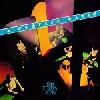A Certain Ratio, "I'd Like To See You Again"
 Anyone who has seen 24 Hour Party People will probably remember severalscenes involving A Certain Ratio. At various points they get smearedwith sunless tanner, are told to dress like boy scouts, and play theinaugural show at Tony Wilson's towering pipedream to self-indulgence,the Hacienda, to an empty house.
Anyone who has seen 24 Hour Party People will probably remember severalscenes involving A Certain Ratio. At various points they get smearedwith sunless tanner, are told to dress like boy scouts, and play theinaugural show at Tony Wilson's towering pipedream to self-indulgence,the Hacienda, to an empty house.
The message that the film seems conveys is clear: A Certain Ratio werean amusing footnote in the story of Factory Records. Ignored as theirpeers in Joy Division and New Order gained popularity and influence,and all but forgotten by the time groups like the Happy Mondays camealong, it’s probably a safe bet to say that the majority of those whosaw 24 Hour Party People had no idea who A Certain Ratio were.This is a damn shame, as one listen to any of A Certain Ratio’s albumsfrom 1979 to about 1983 (when the group began to splinter apart) showsthat they were far ahead of the curve. 1980’s half four-track demos,half live cuts (from their tour with Talking Heads) The Graveyard andthe Ballroom pretty much predicts the recent dance-punk explosion, withthe band laying into precise, skittering funk inflected punk. By thetime of 1982’s I’d Like to See You Again, the band had tradedin the thin guitars and anxious vocals of Simon Topping for somethingfar more lush and organic. To say I was shocked at the difference insound and approach between The Graveyard and the Ballroom and I’d Like to See You Againwould be an understatement. Gone were the pent up vocals, wiry guitarsand urgent drumming, in their place were synthesizers, vocoders, andbig, fat bass lines. A Certain Ratio had always been influenced byAmerican funk and disco, but here that influence became more pronouncedthen ever. Opener “Touch” is perhaps the slickest, catchiest bit ofR&B that Parliament never recorded. “Hot Knights” features aswinging beat with some squishy analog synth to keep it buoyed, withsome fun nonsensical lyrics thrown in for good measure. Elsewhere,there are interesting experiments with vocoders, such as on thegraceful disco of “I’d Like to See You Again” and the more driving“Show Case.” The highlight though is “Axis,” which features some trulyjaw dropping bass work from Jeremy Kerr and grooves languidly on afoundation of tightly syncopated beats and well placed keyboard riffs.The song manages to incorporate not just the bands love of funk andR&B, but also reveals the influence of New York’s early 80selectro-dance scene, something the band had been listening toobsessively at the time. In addition to the eight original tracks, LTMhas also included five bonus tracks. While the original songs on I’dLike to See You Again were born mostly out of the bands fascinationwith American R&B, these five tracks display the growing influenceof Latin jazz (“Tumba Rhumba”), house music (“Knife Slits Water”), andthe cut and paste attitude of hip-hop (a remix of I’d Like to See YouAgain’s “Guess Who”). Though they don’t necessarily fit in with theoverall flow of the album, they nevertheless showcase the band’sinventive chops and strong sense of ensemble playing. Those who came toknow A Certain Ratio from their earlier, more punk influenced workmight be caught off guard or even put off by the songs here. Icertainly was. But it would be unfair to not to give this release theattention it deserves. While not as immediate or raw as anything foundon The Graveyard and the Ballroom, the songs on I’d Like to See You Again exhibit a strong sense of sophistication and stylistic development.
samples:



